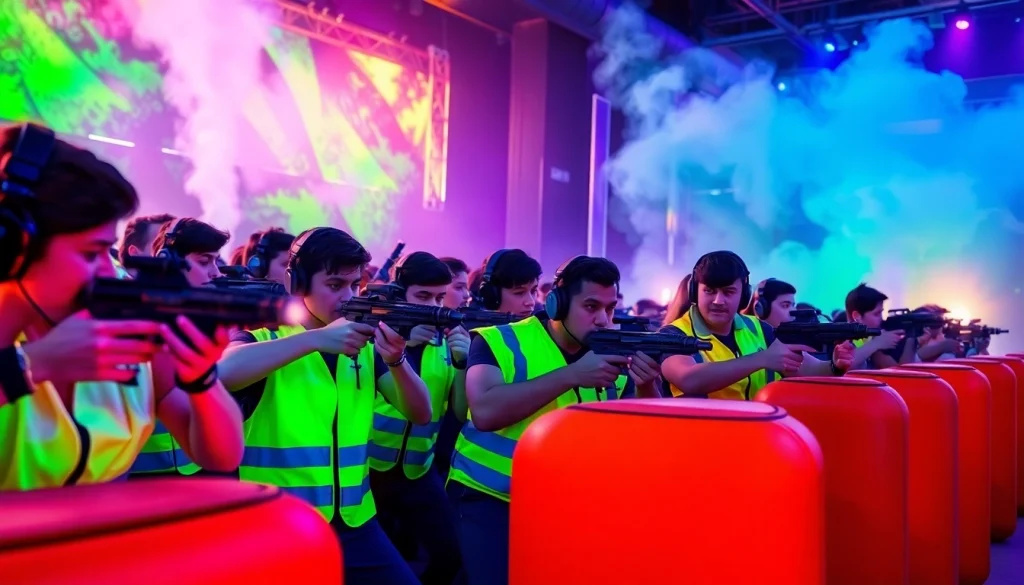1. What is Laser Tag and How Does it Work?
Laser tag is an exhilarating recreational shooting sport where players use infrared-emitting light guns to “tag” opponents, marked targets, or objects within a designated play area. The objective of the game often varies based on personalized strategies and rules defined by the venue or group of players. Being an engaging activity combining elements of strategy, teamwork, and physical agility, laser tag has garnered immense popularity in venues across the globe.
1.1 The Basics of Laser Tag
At its core, laser tag operates on simple mechanics. Players equip themselves with laser taggers, which are specially designed guns that emit infrared beams. The game can take place in various environments such as indoor arenas filled with obstacles and hiding spots or outdoor fields with natural scenery. Players typically wear vests equipped with sensors that register hits when struck by another player’s laser beam. Depending on the venue, games can differ in duration but commonly last around 15 minutes, packed with adrenaline-pumping action.
1.2 Equipment Used in Laser Tag
The technology behind laser tag equipment has evolved significantly over the years. Today’s laser tag systems incorporate advanced components, including:
- Laser Taggers: Devices resembling guns equipped with infrared emitters for tagging opponents.
- Vests: Worn by players, these vests feature sensors that detect hits. Some venues offer lightweight options to enhance maneuverability.
- Headsets: Often optional, headsets sometimes allow for team communication during the game.
- Scoring Systems: These systems track player scores, remaining lives, and game statistics, enhancing competition and excitement.
1.3 The Concept of Tagging and Scoring
Scoring in laser tag primarily revolves around the number of successful hits a player lands on opponents. Venues may implement a variety of scoring systems depending on their rules. Common scoring methods include:
- Basic Scoring: Each successful tag awards points, with the player or team accumulating the highest total winning.
- Elimination Scoring: Players lose lives when tagged, often culminating in a last-player-standing or last-team-standing style of play.
- Objective-Based Scoring: Teams may earn points by completing specific objectives or missions throughout the game, adding strategic elements to gameplay.
2. Benefits of Playing Laser Tag
Engaging in laser tag offers numerous benefits extending beyond mere entertainment. Key advantages include physical, mental, and social gains, making it an attractive option for individuals and groups alike.
2.1 Physical Health Benefits
Playing laser tag involves considerable amounts of movement, contributing to various health benefits. Regular participation can lead to improved fitness through:
- Cardiovascular Health: The fast-paced nature of the game provides an excellent cardiovascular workout, helping players enhance endurance and overall stamina.
- Strength and Agility: Navigating through obstacles and executing tactical maneuvers build strength and agility, particularly in lower body muscles.
- Coordination: Laser tag incorporates aiming and dodging, which improves hand-eye coordination and reflexes.
2.2 Mental and Social Advantages
Participating in laser tag isn’t solely about physical fitness; it offers significant mental and social boosts:
- Strategic Thinking: Players must devise strategies, assess their surroundings, and react quickly, sharpening mental acuity and decision-making skills.
- Teamwork: Laser tag promotes collaboration and communication among teammates, reinforcing social bonds and developing interpersonal skills.
- Stress Relief: The immersive nature of the game offers a fun distraction from daily stresses, fostering relaxation and enjoyment.
2.3 Engaging Teams and Strategies
Laser tag serves as a fantastic team-building exercise. Organizations often use it as a recreational activity to foster teamwork among employees. Engaging in tactical gameplay encourages:
- Leadership Development: Team members may assume leadership roles, enhancing their leadership skills.
- Problem-Solving Skills: Teams learn to navigate challenges together, boosting collective problem-solving capabilities.
- Communication Skills: Effective communication is crucial for success, allowing team members to develop strong verbal and non-verbal communication skills.
3. Planning a Laser Tag Event
Whether organizing a birthday party, corporate team-building exercise, or casual outing with friends, careful planning ensures a successful laser tag event. Below are crucial considerations to bear in mind.
3.1 Choosing the Right Venue
Selecting the appropriate location for your laser tag event can enhance the overall experience. Factors to consider include:
- Type of Setup: Decide between indoor arenas or outdoor fields based on participant preferences and weather conditions.
- Capacity: Ensure the venue can accommodate your group size comfortably.
- Amenities: Look for venues that offer additional facilities such as food services, rest areas, and party rooms to enhance convenience.
3.2 Pricing Structures and Packages
Understanding pricing is essential for budget management. Common packages may include:
- Per-Game Pricing: Pay-per-game rates often range from $7 to $12 per person for a single session.
- Group Packages: Venues typically offer discounts for larger groups, enabling better affordability for events.
- Combo Packages: Some establishments bundle laser tag with food options, providing a comprehensive entertainment package.
3.3 Important Considerations for Safety
Ensuring a safe environment for all participants is paramount. Essential safety measures include:
- Equipment Checks: Regular checks on equipment ensure all taggers and vests are functioning correctly to prevent malfunctions during gameplay.
- Rules Communication: Clearly communicate rules and guidelines to all players, emphasizing the importance of following safety protocols during matches.
- Supervision: Designated supervisors can help monitor gameplay and provide assistance as necessary.
4. Laser Tag for Different Age Groups
Laser tag is a versatile activity that appeals to a wide range of ages. Understanding how to tailor experiences for different age groups can maximize enjoyment and participation.
4.1 Recommended Ages for Participation
Laser tag is generally suitable for children aged six and above. The complexity and fast-paced nature of the game can be challenging for younger children, making age-appropriate adaptations vital for a positive experience.
4.2 Adaptations for Younger Players
When including younger children, consider the following adaptations:
- Shorter Game Durations: Reduce game time to accommodate shorter attention spans, allowing more frequent breaks.
- Smaller-Scale Arenas: Set up smaller play areas that create a less intimidating environment while still providing fun.
- Modified Equipment: Utilize lightweight equipment suitable for younger players to promote engagement and enjoyment.
4.3 Family-Friendly Game Options
Family-friendly laser tag events can be organized to foster togetherness. Look for venues that offer family combo packages, allowing parents and children to participate together in a shared experience.
5. Tips for Winning at Laser Tag
Winning at laser tag requires more than just aiming well; it necessitates strategic thinking, teamwork, and practice. Here are valuable tips aimed at enhancing performance in the arena.
5.1 Team Dynamics and Communication
Establishing effective communication is central to a team’s success in laser tag. Teams should:
- Use Callouts: Agree on simple callouts to communicate enemy locations and strategies during gameplay.
- Form Strategies: Develop a game plan outlining team roles, such as defenders and attackers, to optimize position during gameplay.
5.2 Strategies for Different Game Types
Understanding the specific game type is crucial for strategic planning. Different game types may require varying strategies:
- Elimination Games: Focus on teamwork to protect weaker players and eliminate opponents systematically.
- Capture the Flag: Coordinate between attackers and defenders, ensuring that defenders safeguard your flag while attackers attempt to capture the enemy flag.
5.3 Improving Your Skills and Accuracy
Performance improvement comes with practice and skill development:
- Focus on Stealth: Develop skills to move silently and avoid detection, enhancing chances of tagging opponents.
- Train for Accuracy: Regular practice will improve aiming precision with the laser tagger, enhancing overall effectiveness during gameplay.



